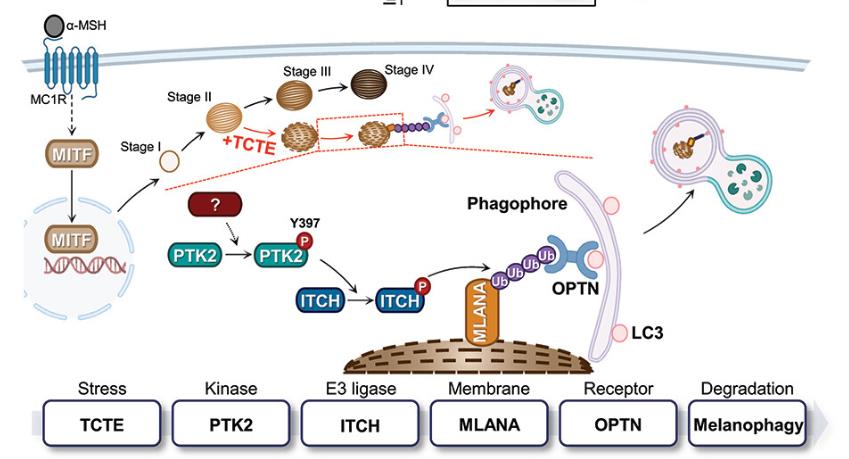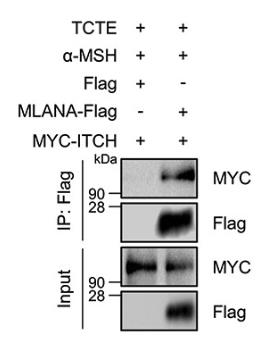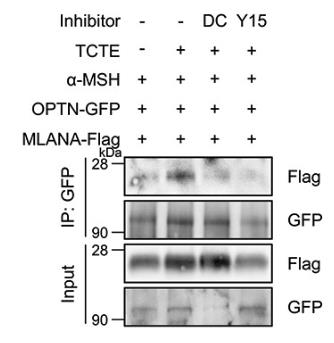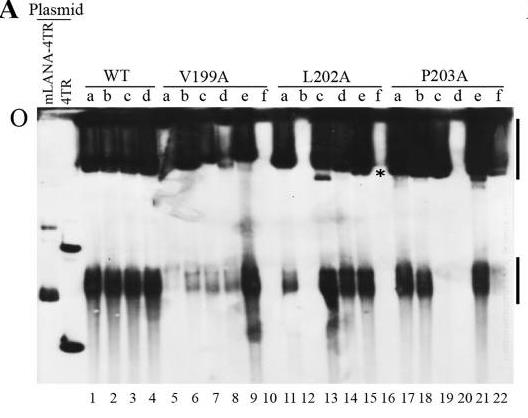MLANA
-
Official Full Name
MLANA melan-A -
Overview
Involved in melanosome biogenesis by ensuring the stability of GPR143. Plays a vital role in the expression, stability, trafficking, and processing of melanocyte protein PMEL, which is critical to the formation of stage II melanosomes. -
Synonyms
MLANA;melan-A;melanoma antigen recognized by T-cells 1;MART1;antigen LB39-AA;antigen SK29-AA;protein Melan-A;MART-1
Recombinant Proteins
- Human
- Mouse
- E.coli
- Wheat Germ
- HEK293
- Mammalian Cells
- Yeast
- In Vitro Cell Free System
- GST
- Non
- B2M
- His
- DDK
- Myc
- Flag
- Avi
- Fc
| Cat.# | Product name | Source (Host) | Species | Tag | Protein Length | Price |
|---|---|---|---|---|---|---|
| MLANA-2040H | Recombinant Human MLANA, GST-tagged | E.coli | Human | GST | 1-118aa | |
| MLANA-7635H | Recombinant Human MLANA, His-tagged | E.coli | Human | Non | 48-118aa | |
| MLANA-112H | Recombinant Human MLANA | E.coli | Human | Non |
|
|
| MLANA-1282H | Recombinant Human MLANA Protein, His-B2M-tagged | E.coli | Human | B2M&His | 1-118 a.a. |
|
| MLANA-2043H | Recombinant Human Melan-A | E.coli | Human | Non | Full L. |
|
| MLANA-30193TH | Recombinant Human MLANA | Wheat Germ | Human | Non | 118 amino acids |
|
| MLANA-585H | Recombinant Human MLANA Protein, MYC/DDK-tagged | HEK293 | Human | DDK&Myc |
|
|
| MLANA-411HCL | Recombinant Human MLANA lysate | HEK293 | Human | Non |
|
|
| MLANA-1074HFL | Recombinant Full Length Human MLANA Protein, C-Flag-tagged | Mammalian Cells | Human | Flag | Full L. |
|
| MLANA-1417H | Recombinant Human MLANA Protein, His (Fc)-Avi-tagged | HEK293 | Human | Avi&Fc&His |
|
|
| MLANA-1417H-B | Recombinant Human MLANA Protein Pre-coupled Magnetic Beads | HEK293 | Human |
|
||
| MLANA-1658H | Recombinant Human MLANA Protein (1-118 aa), His-tagged | Yeast | Human | His | 1-118 aa |
|
| MLANA-308HF | Recombinant Full Length Human MLANA Protein | In Vitro Cell Free System | Human | Full L. 118 amino acids |
|
|
| Mlana-4088M | Recombinant Mouse Mlana Protein, Myc/DDK-tagged | HEK293 | Mouse | DDK&Myc |
|
|
| MLANA-4686H | Recombinant Human MLANA Protein, Myc/DDK-tagged, C13 and N15-labeled | HEK293 | Human | DDK&Myc |
|
|
| MLANA-5379H | Recombinant Human MLANA Protein, GST-tagged | Wheat Germ | Human | GST |
|
|
| MLANA-6349HF | Recombinant Full Length Human MLANA Protein, GST-tagged | In Vitro Cell Free System | Human | GST | Full L. 118 amino acids |
|
| MLANA-882H | Recombinant Human MLANA protein, His-tagged | E.coli | Human | His | 1-118 aa |
|
Background
What is MLANA Protein?
The MLANA protein, also known as Melan-A or MART-1, is specifically expressed in melanocytes and plays a key role in the creation of melanosomes. It’s crucial for the development and function of these pigment-producing cells. MLANA helps maintain GPR143 stability and influences the expression, stability, transport, and processing of the melanosome protein PMEL. Beyond these roles, MLANA acts as an immunogen, meaning it can trigger T-cell immune responses, playing a part in both anti-tumor immunity and autoimmune processes. In conditions like melanoma and other pigment-related disorders, MLANA levels are often elevated, making it a useful marker for these types of tumors.What is the Function of MLANA Protein?
The MLANA protein, also known as Melan-A or MART-1, is a special antigen found in melanocytes—the cells that make melanin. This protein is essential in the creation of melanosomes, which are the structures that produce and hold melanin. MLANA is important for helping melanocytes grow and function properly. It does this by keeping GPR143 stable and overseeing how the melanosome protein PMEL is expressed, stabilized, transported, and processed. Additionally, MLANA acts as an immunogen, which means it can stimulate immune responses from T-cells. This is significant in both fighting tumors and in autoimmune reactions. Notably, in diseases related to melanin production like melanoma, MLANA levels are typically elevated, which is why it serves as an important marker for these types of cancers.MLANA Related Signaling Pathway
The MLANA protein, also called Melan-A or MART-1, plays a key role in how melanosomes are made in melanocytes, the cells that produce pigment. It helps by keeping GPR143 stable and by managing how the protein PMEL is expressed, stabilized, transported, and processed in these pigment cells. Besides that, MLANA acts as an immunogen, sparking T-cell immune responses. This makes it a player in fighting tumors and dealing with autoimmune reactions. In pigment-related illnesses like melanoma, MLANA levels are often high, so it's used as a marker to identify these tumors.
Fig1. Schematic diagram of a novel melanophagy mechanism involving the PTK2-ITCH-MLANA-OPTN cascade. (Na Yeon Park, 2024)
MLANA Related Diseases
The MLANA protein, known as Melan-A or MART-1, is linked to various diseases, playing a crucial role particularly in melanoma. It's a specific antigen found in melanocytes, and its levels are usually elevated in melanoma, which makes it a useful marker for this type of cancer. Beyond melanoma, MLANA also matters in other pigment-related diseases like conjunctival melanoma and intraocular melanoma. Its high expression aids not only in diagnosing tumors but also serves as a target for immunotherapy. By activating T-cell immune responses, it participates in the body’s fight against tumors.Bioapplications of MLANA
The MLANA protein finds its place in a variety of applications across research, industrial production, and clinical studies. In the research world, MLANA serves as a melanocyte-specific antigen and is widely used to explore the mechanisms behind melanoma and the heterogeneity of tumor cells. It also plays a key role when melanoma cells undergo differentiation and dedifferentiation, impacting treatment outcomes by regulating cell states and drug resistance. On the industrial side, MLANA antibodies and detection methods are crucial for developing experimental reagents and research tools, aiding scientists in understanding its function in melanoma. Clinically, MLANA acts as a marker for diagnosing and monitoring melanoma. It's particularly promising in detecting circulating tumor cells (CTCs), offering potential advancements in tumor tracking.Case Study
Case Study 1: Park NY. et al. Autophagy. 2024
Researchers have identified the role of melanosomes in skin color and UV protection, but the breakdown process, melanophagy, remains less understood. They found that 3,4,5-trimethoxycinnamate thymol ester (TCTE) reduces skin pigmentation by activating melanophagy. In TCTE-treated melanocytes, ITCH tags the melanosome protein MLANA, which is then recognized by the protein OPTN. TCTE activates PTK2, enhancing ITCH's tagging of MLANA. Blocking PTK2 or ITCH stops MLANA's interaction with OPTN. This reveals the importance of the PTK2-ITCH-MLANA-OPTN pathway in melanophagy.-
 Fig1. α-MSH-stimulated B16F1 cells were transfected with MYC-ITCH in combination with either Flag or MLANA-Flag.
Fig1. α-MSH-stimulated B16F1 cells were transfected with MYC-ITCH in combination with either Flag or MLANA-Flag. -
 Fig2. α-msh-stimulated B16F1 cells were cotransfected with MLANA-Flag and OPTN-GFP for 24 h.
Fig2. α-msh-stimulated B16F1 cells were cotransfected with MLANA-Flag and OPTN-GFP for 24 h.
Case Study 2: Cerqueira SA. et al. J Virol. 2016
Researchers have found that viruses can manipulate the cell's ubiquitination system by hijacking E3 ubiquitin ligases, but the impact of this on viral disease is not fully understood. Using murid herpesvirus 4 (MuHV-4) in mice, they explored how the E3 ligase activity of MuHV-4's latency protein, mLANA, affects infection. Specific mutations in the mLANA SOCS box disrupted its ability to form a complex with other proteins, affecting its activity on host NF-κB and Myc. While these mutations reduced mLANA's DNA binding, they didn't stop it from maintaining viral episomes. In infected mice, mutated viruses showed weakened latency in germinal center B cells, highlighting mLANA’s role in viral-induced cell proliferation. This suggests that targeting SOCS box motifs could be a strategy to control virus-related diseases.-
 Fig3. Anti-FLAG Western blot of in vitro-translated mLANA used in EMSAs.
Fig3. Anti-FLAG Western blot of in vitro-translated mLANA used in EMSAs. -
 Fig4. MEFs were transfected with mLANA-4TR, m4TR, or mLANA mutants.
Fig4. MEFs were transfected with mLANA-4TR, m4TR, or mLANA mutants.
Quality Guarantee
High Purity
-
.jpg) Fig1. SDS-PAGE (MLANA-1282H)
Fig1. SDS-PAGE (MLANA-1282H) -
.jpg) Fig2. SDS-PAGE (MLANA-4686H)
Fig2. SDS-PAGE (MLANA-4686H)
Involved Pathway
MLANA involved in several pathways and played different roles in them. We selected most pathways MLANA participated on our site, such as , which may be useful for your reference. Also, other proteins which involved in the same pathway with MLANA were listed below. Creative BioMart supplied nearly all the proteins listed, you can search them on our site.
| Pathway Name | Pathway Related Protein |
|---|
Protein Function
MLANA has several biochemical functions, for example, protein binding. Some of the functions are cooperated with other proteins, some of the functions could acted by MLANA itself. We selected most functions MLANA had, and list some proteins which have the same functions with MLANA. You can find most of the proteins on our site.
| Function | Related Protein |
|---|---|
| protein binding | UBE2W,ZFP259,TIPIN,IPO13,KCP,PPM1F,LLGL1,SMCP,MPPE1,ATXN7 |
Interacting Protein
MLANA has direct interactions with proteins and molecules. Those interactions were detected by several methods such as yeast two hybrid, co-IP, pull-down and so on. We selected proteins and molecules interacted with MLANA here. Most of them are supplied by our site. Hope this information will be useful for your research of MLANA.
GPR143;NEDD4;ITCH
Resources
Related Services
Related Products
References


